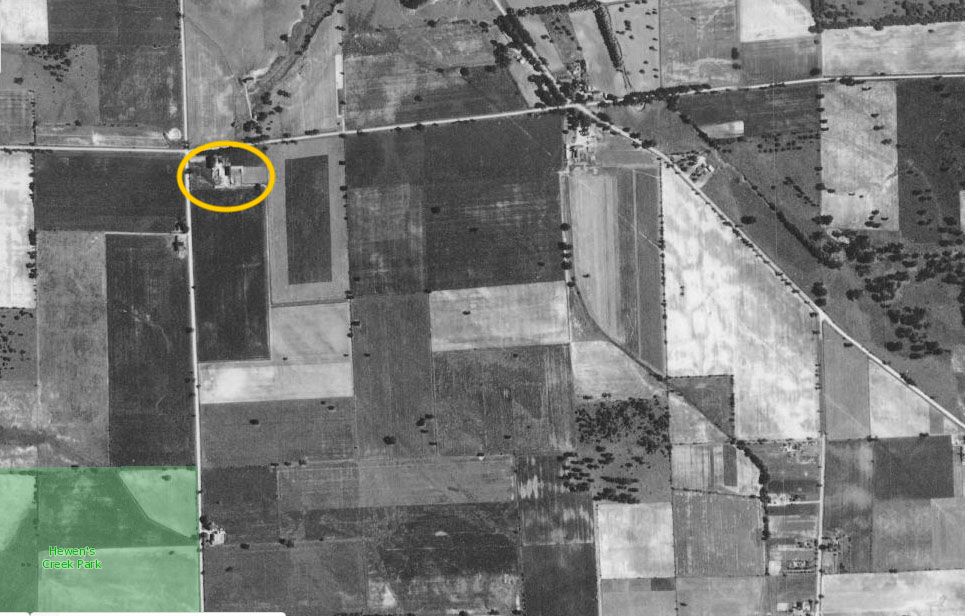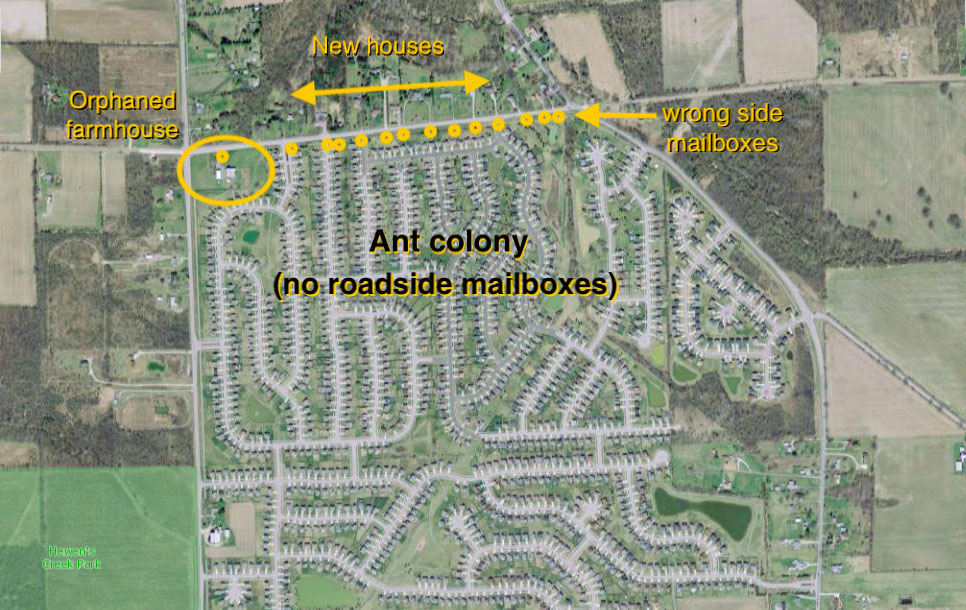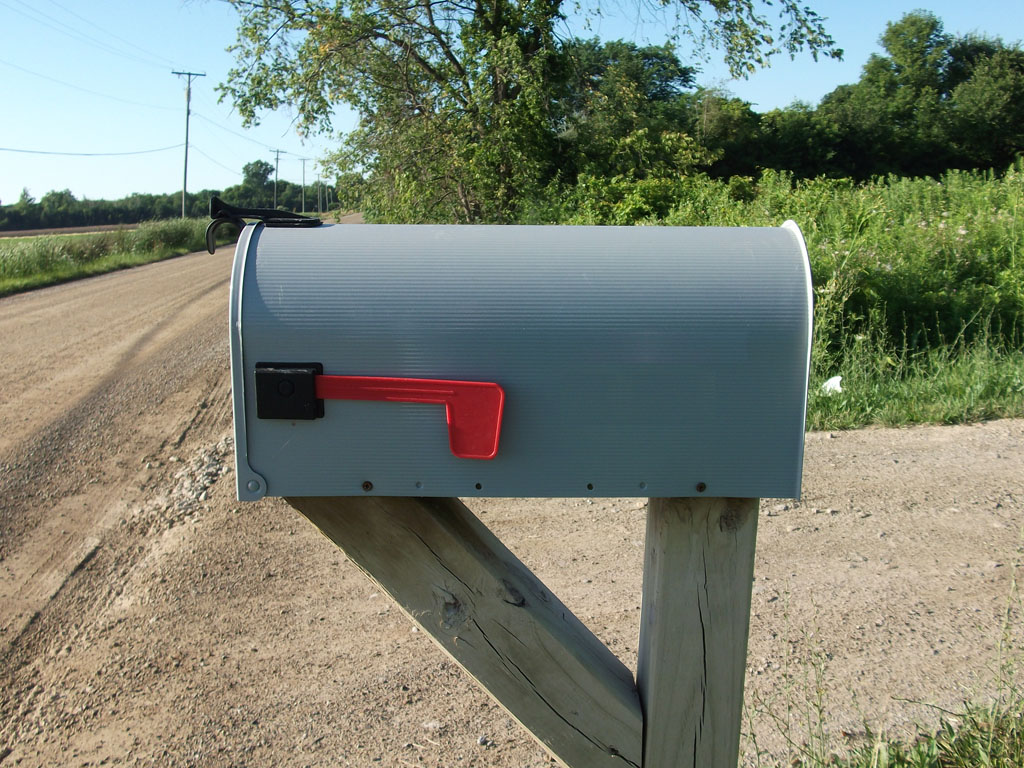There are two classes of rural homes: those with a mailbox on the same side of the road, and those with a mailbox on the other.
In the US, where cars drive on the right side of the road, the carrier can only deliver to mailboxes that can be reached from the right side of the delivery vehicle. If the mailboxes are scattered across both sides of the road, the carrier would have to make two passes to deliver to every mailbox on the road.
But postmaster policy is to minimize delivery mileage, by delivering mail to all houses in a single pass when possible. This would mean that, ideally, every mailbox should be on the same side of the road, even when the houses are not.
Long ago, when houses in rural areas were sparse, this was not much of an issue. When a farm family wished to exercise their right to rural free delivery, the farmer would simply place the mailbox at the end of the driveway, right at the property line. Since each “block” was often half a mile to a mile long, and often there was only one house along the stretch, the route could often be designed around the existing houses, and still have most of the mail delivered in a single pass. In the rare circumstance that two farmhouses were opposite each other, the carrier might simply deliver to the opposite side as needed, or might simply make it a turnaround point on the route.
Thus in the rural area where I grew up, all of the old farmhouses had the mailbox placed on their own side. Yet, I also noticed the strange fact that there were many other, seemingly newer houses where the mailbox was on the opposite side. Riding along in the back seat, I would often witness residents crossing the road in front of our car, to retrieve their mail. How inconvenient, I would think — we didn’t have to do that, so why did they?
Grandfathered out
It’s because, by then, the routes were well established by the locations of the farmhouses, and the dozens of new houses that were gradually popping up on subdivided outlots of larger farmsteads in the 1960s would have made it impossible to deliver the mail without traveling both sides of the road — doubling the length of every route. Thus, these new houses were instructed to conform to the delivery routes, even if it meant their mailbox had to be placed on the other side of the road. So, wherever the 1870s farmhouse was later joined by a passel of 1960s bungalows sprouting on the other side like weeds in a vacant field, their residents would have to cross the road, twice, to bring in their mail. If they were unhappy about it, they were probably not as unhappy as the lingering farmer across the road, who now had these new neighbors cluttering his bucolic frontage with their tacky mailboxes.
Denying suburbia
As a person who opposes the creeping suburbanization of the countryside, I find delicious justice in this small measure of passive resistance, delivered by the institutional inertia of the postal system. Even a long-demolished, century-old farmhouse can create a permanent ghost of itself by “locking in” the side on which mail delivery occurs. This is because, once a route is established, it effectively cannot be changed without great effort.
As a case in point, I have often driven a certain stretch of road, where a motley collection of houses of varying design and origin have collected over the years, on one side of the road — and all of their mailboxes are placed on the side opposite the house. This may seem incredibly inefficient — why not change the route and let them get their mail without having to cross a dangerous road?
Of course, this is not as practical as it sounds. Technically, once a homeowner purchases a mailbox and places it into service, it is the property of the U.S. Postal Service, until it is taken out of service. However, the posts on which they are mounted still belong to the homeowner. Moving a mailbox post costs time and money, and depends on the cooperation of every homeowner on the route. The postmaster cannot do it for them, and partial cooperation would create an even worse situation. Thus, these routes are about as locked in as they can be.
This means that mail routes, and the odd placement of mailboxes, are a useful forensic clue to interpreting the settlement of an area over time.
This is illustrated by the stretch of road I just mentioned. At the end of this half-mile stretch of wrong-side mailboxes, there is a very old farmhouse — on the same side of the road as these displaced mailboxes. After two centuries, its mailbox remains comfortably at the end of its owner’s drive, on the same side. Each house that incrementally settled parts of the field across the road had to conform with that placement. Over the years, it led to the odd sight of a dozen or more houses, all of which have wrong-side mailboxes. It’s as if the ghost of the farmer is snickering at them from the other side.
The presence of the farmhouse on that corner tells us that it controlled and protected a very large parcel of land for a very long time, that through this singular ownership was able to resist being subdivided gradually by two- to three-acre residential lots, as happened on the other side.
As we see below, this was indeed the case. In 1940, the sprawling patchwork of variously utilized fields likely belonged to the house that is circled, which still has a properly placed mailbox today. On the north side of the road, there were no neighbors at all, but they were coming.

By 2010 (below), a lot of neighbors have appeared. For the moment, ignore the ant colony of cul-de-sacs to the south. Looking at the north side of the road, it has gradually sprouted an assortment of quasi-suburban houses — and, one at a time, they would each install a mailbox. The mailboxes were duly placed on the opposite side of the road, one at a time, post-in-ground, because that was the carrier’s route.

Looking now to the south side of the road, we can also see that, at some point, the farmhouse has had its boundaries reduced to a tiny lot, and its new neighbor is a large development of several hundred new houses, constructed on the land it formerly commanded. From the air, it remarkably resembles an ant colony. How does such a thing happen?

Sadly, as much as we might like to think of the farmer’s long preservation of the large tract of land to the south as a positive thing, it perversely led to a tragedy — the opportunity for an investment firm to swoop in and purchase the entire parcel when the farmer moved on, thus making it possible to construct the aforementioned ant colony.
Portrait of three evils
To some degree, I suppose the motley collection of houses on the north side of the road deserves at least a little credit, for being just a shade less rapacious. But neither outcome is remotely natural, and neither is sustainable. In fact, the modern farm that might have instead occupied this space would not be that great either, if intensively cultivated with chemical fertilizers to grow GMO corn. Even the farm of 1940 was essentially treeless, in a region that otherwise would be naturally forested.
This is why I love the wrong-side mailbox – it is a signal from the past, saying something about a misdirected future, that we still are yet learning to hear.
Article and images Copyright 2021 by the author.



One Comment
Ross Gladwin
Ugh! Just found this post but it perfectly summarizes my own road’s mail delivery. Whatever house or farm used to be on the other side of the road on our mile-long block is long gone, with subdivisions and condo developments in it’s place on the east side. On our west side of the road, ~15 of us neighbors have to cross a dangerous 45+mph road to get our mail. Zero homeowners on the east side of the road. We have been able to determine that if we all simply moved our mailboxes, the USPS would be forced to comply and deliver our mail. BUT, if only a couple of us do it, we’re SOL. Ugh.